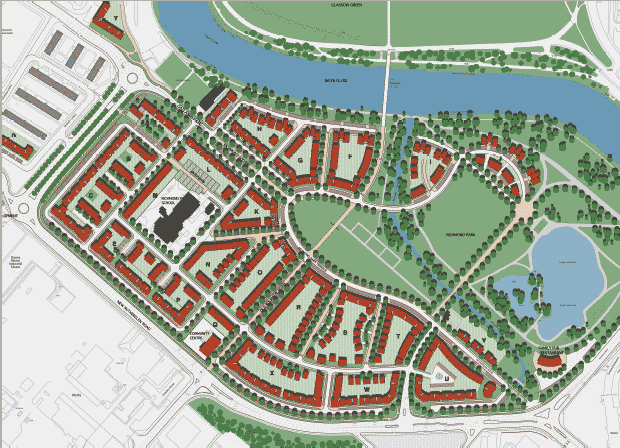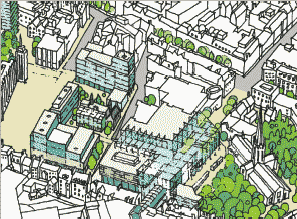Planning Advice Note 83: master planning
This Planning Advice Note (PAN) 83 covers the masterplanning process from beginning to end.
This document is part of a collection
Understanding masterplanning
What
is a masterplan?
Why
do we need to masterplan?
What
is an effective masterplan?
When
is a masterplan required?
What is a masterplan?
The definition of what constitutes a masterplan can vary. In broad terms, a masterplan comprises three dimensional images and text describing how an area will be developed. Its scope can range from strategic planning at a regional scale to small scale groups of buildings. Most commonly, it is a plan that describes and maps an overall development concept, including present and future land use, urban design and landscaping, built form, infrastructure, circulation and service provision. It is based upon an understanding of place and it is intended to provide a structured approach to creating a clear and consistent framework for development.
Whereas a development plan sets out the scale and type of development, and the key principles of character for a region, a masterplan is generally employed where there is a greater degree of certainty regarding the development of a specific site, and is linked to social and economic analysis and a delivery strategy. Although a masterplan may specify more detailed governing principles such as building heights, spaces, movement, landscape type and predominant uses, it does not necessarily preclude a degree of flexibility in designs within the plan.
manage and deliver
Numerous documents called masterplans are already
produced for many different sites but what is needed is
more effective masterplanning, and people who know
how to manage and deliver the process successfully.
Why do we need to masterplan?
Masterplanning can help to raise the general standards of urban design and create quality places. The alternative approach can result in the development of buildings and spaces that lack coherence and waste the potential of the site. We therefore rely on masterplans to:
- provide the appropriate physical environments to support strong communities;
- support a rich and pleasurable quality of life for inhabitants and visitors;
- connect people and places by providing ease of movement within, and through, developments; and
- create places of distinction and enduring quality.
Masterplanning can help to achieve these outcomes by providing a structured approach and framework to a wide range of complex issues. If done well, masterplanning can promote sustainability, in its widest sense, and deliver places where people will want to live.

What is an effective masterplan?
An effective masterplan should explain how a site, or series of sites, will be developed, describing and illustrating the proposed urban form in three dimensions. It should show how that form will achieve the intended vision for the place, and how a distinct and appropriate character will be created. It should also describe how the project will be implemented through a delivery strategy which sets out phasing, timing and funding. Important aspects for consideration include:
- clear brief based on a thorough assessment of the site and its needs
- client commitment to produce a quality development
- appointment of a multi-disciplinary team who all recognise the benefit of masterplanning
- confidence that all parties are clear about what is needed, and how this should be achieved
- accurate interpretation of the social, environmental and economic context of the site and its surroundings
- appreciation of planning policies, transport, utility and service requirements
- collaboration with communities, and organisations, with either a stake or an interest in the area
- communication of ideas without jargon, using plain English and simple illustrations
- awareness of the market and economic realities
- proposals that are appropriate and realistic
- ability to deliver the vision.
The ultimate test of an effective masterplan will be how the outcome benefits the full range of people who use, and chose to stay in the place, often over decades or generations.
When is a masterplan required?
A masterplan can be prepared for almost any site, but there are certain types of sites or circumstances where a masterplan is most likely to be appropriate. In general, masterplanning is required for areas of large-scale change such as town extensions; regeneration projects; town and city centres; housing developments; and places where significant environmental assets require protection. Masterplanning, however, is also relevant to raising standards in relatively small developments.
Masterplans are usually commissioned by local authorities, developers, housebuilders, landowners and regeneration agencies or by any of these in partnership. One, or all, should assess the site and decide what contribution a masterplan could make.
Areas of significant change

- where a structured and integrated framework for urban growth is required;
- where a strategy is required for the regeneration of an area;
- where a new settlement is proposed;
- where there are multiple developers or landowners; or
- where a major event (such as the Commonwealth Games) is driving regeneration.
Sensitive areas

- where significant or important environmental assets need to be protected;
- where there are complex issues such as differences in agendas between developers or landowners; or
- where there are significant ecological and green network considerations.
Certain small-scale developments

- where the cumulative effect of many small developments may be significant; many developments in Scotland are no more than 10 houses, but they can impact on the landscape or the setting of villages and small towns.
Sites specifically identified

- where, in the formulation of their development plans, planning authorities have identified specific sites, neighbourhoods or areas that require a masterplan.
Contact
Email: chief.planner@gov.scot
Telephone: 0131 244 7528
Post:
Area 2-H (South)
Planning and Architecture Division
The Scottish Government
Victoria Quay
Edinburgh
EH6 6QQ
There is a problem
Thanks for your feedback